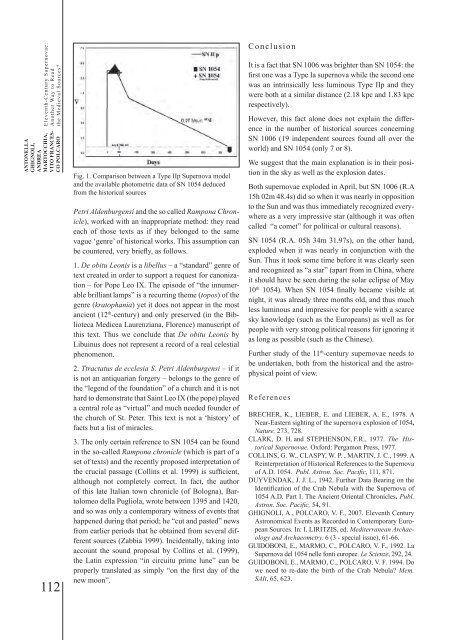BALTICA10
BALTICA10
BALTICA10
Create successful ePaper yourself
Turn your PDF publications into a flip-book with our unique Google optimized e-Paper software.
Eleventh-Century Supernovae:<br />
Another Way to Read<br />
the Medieval Sources?<br />
ANTONELLA<br />
GHIGNOLI,<br />
ANDREA<br />
MARTOCCHIA,<br />
VITO FRANCES-<br />
CO POLCARO<br />
112<br />
Fig. 1. Comparison between a Type IIp Supernova model<br />
and the available photometric data of SN 1054 deduced<br />
from the historical sources<br />
Petri Aldenburgensi and the so called Rampona Chronicle),<br />
worked with an inappropriate method: they read<br />
each of those texts as if they belonged to the same<br />
vague ‘genre’ of historical works. This assumption can<br />
be countered, very briefly, as follows.<br />
1. De obitu Leonis is a libellus – a “standard” genre of<br />
text created in order to support a request for canonization<br />
– for Pope Leo IX. The episode of “the innumerable<br />
brilliant lamps” is a recurring theme (topos) of the<br />
genre (kratophania) yet it does not appear in the most<br />
ancient (12 th -century) and only preserved (in the Biblioteca<br />
Medicea Laurenziana, Florence) manuscript of<br />
this text. Thus we conclude that De obitu Leonis by<br />
Libuinus does not represent a record of a real celestial<br />
phenomenon.<br />
2. Ttractatus de ecclesia S. Petri Aldenburgensi – if it<br />
is not an antiquarian forgery – belongs to the genre of<br />
the “legend of the foundation” of a church and it is not<br />
hard to demonstrate that Saint Leo IX (the pope) played<br />
a central role as “virtual” and much needed founder of<br />
the church of St. Peter. This text is not a ‘history’ of<br />
facts but a list of miracles.<br />
3. The only certain reference to SN 1054 can be found<br />
in the so-called Rampona chronicle (which is part of a<br />
set of texts) and the recently proposed interpretation of<br />
the crucial passage (Collins et al. 1999) is sufficient,<br />
although not completely correct. In fact, the author<br />
of this late Italian town chronicle (of Bologna), Bartolomeo<br />
della Pugliola, wrote between 1395 and 1420,<br />
and so was only a contemporary witness of events that<br />
happened during that period; he “cut and pasted” news<br />
from earlier periods that he obtained from several different<br />
sources (Zabbia 1999). Incidentally, taking into<br />
account the sound proposal by Collins et al. (1999),<br />
the Latin expression “in circuitu prime lune” can be<br />
properly translated as simply “on the first day of the<br />
new moon”.<br />
Conclusion<br />
It is a fact that SN 1006 was brighter than SN 1054: the<br />
first one was a Type Ia supernova while the second one<br />
was an intrinsically less luminous Type IIp and they<br />
were both at a similar distance (2.18 kpc and 1.83 kpc<br />
respectively).<br />
However, this fact alone does not explain the difference<br />
in the number of historical sources concerning<br />
SN 1006 (19 independent sources found all over the<br />
world) and SN 1054 (only 7 or 8).<br />
We suggest that the main explanation is in their position<br />
in the sky as well as the explosion dates.<br />
Both supernovae exploded in April, but SN 1006 (R.A<br />
15h 02m 48.4s) did so when it was nearly in opposition<br />
to the Sun and was thus immediately recognized everywhere<br />
as a very impressive star (although it was often<br />
called “a comet” for political or cultural reasons).<br />
SN 1054 (R.A. 05h 34m 31.97s), on the other hand,<br />
exploded when it was nearly in conjunction with the<br />
Sun. Thus it took some time before it was clearly seen<br />
and recognized as “a star” (apart from in China, where<br />
it should have be seen during the solar eclipse of May<br />
10 th 1054). When SN 1054 finally became visible at<br />
night, it was already three months old, and thus much<br />
less luminous and impressive for people with a scarce<br />
sky knowledge (such as the Europeans) as well as for<br />
people with very strong political reasons for ignoring it<br />
as long as possible (such as the Chinese).<br />
Further study of the 11 th -century supernovae needs to<br />
be undertaken, both from the historical and the astrophysical<br />
point of view.<br />
References<br />
BRECHER, K., LIEBER, E. and LIEBER, A. E., 1978. A<br />
Near-Eastern sighting of the supernova explosion of 1054,<br />
Nature, 273, 728.<br />
CLARK, D. H. and STEPHENSON, F.R., 1977. The Historical<br />
Supernovae. Oxford: Pergamon Press, 1977.<br />
COLLINS, G. W., CLASPY, W. P. , MARTIN, J. C., 1999. A<br />
Reinterpretation of Historical References to the Supernova<br />
of A.D. 1054. Publ. Astron. Soc. Pacific, 111, 871.<br />
DUYVENDAK, J. J. L., 1942. Further Data Bearing on the<br />
Identification of the Crab Nebula with the Supernova of<br />
1054 A.D. Part I. The Ancient Oriental Chronicles. Publ.<br />
Astron. Soc. Pacific, 54, 91.<br />
GHIGNOLI, A., POLCARO, V. F., 2007. Eleventh Century<br />
Astronomical Events as Recorded in Contemporary European<br />
Sources. In: I. LIRITZIS, ed. Mediterranean Archaeology<br />
and Archaeometry, 6 (3 - special issue), 61-66.<br />
GUIDOBONI, E., MARMO, C., POLCARO, V. F., 1992. La<br />
Supernova del 1054 nelle fonti europee. Le Scienze, 292, 24.<br />
GUIDOBONI, E., MARMO, C., POLCARO, V. F. 1994. Do<br />
we need to re-date the birth of the Crab Nebula? Mem.<br />
SAIt, 65, 623.
















